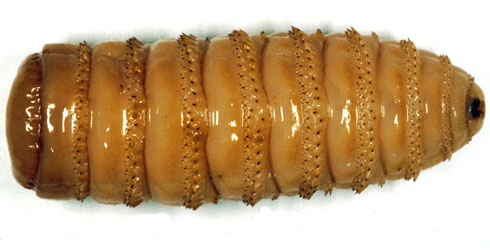Biology
Larvae range from about 2mm in length on hatching to about 40mm when mature. The body length of adults is approximately 24–35mm with a wing span of over 60mm.
Life cycle
Larvae are obligatory endo-parasites of living African rhinoceros, but adults do not feed. Females lay eggs on African rhinoceros. The eggs probably take less than a week to hatch. After hatching, larvae develop in the host’s stomach over a period of several months. When mature they release their hold on the stomach mucosa, pass through the digestive tract and are excreted with the faeces.
They burrow into the soil under and around the dungpile and pupate, emerging as adults after about 6 weeks for a very brief life (less than 1 week) on the wing.
Because both rhinoceros species defecate in regularly used dungpiles, adult flies are likely to emerge in an area where they have a relatively good chance of encountering a rhinoceros on which to lay their eggs. In South Africa Gyrostigma rhinocerontis has 2 generations per year, with adult flies active in March–April and October–December.
Despite their large size, adults only live for a few days (3–5 days in captivity) because they have very reduced non-functional mouthparts and do not feed. Within that short life span, female flies have to locate a male, mate and then find a new rhinoceros host for their eggs.
Dispersal
Adults of Gyrostigma rhinocerontis are strong fliers, but no estimates of their flight range have been made. There is no known natural migration of this species. However, on several occasions it has been carried unwittingly inside the stomachs of rhinoceros bound for zoos in Europe, Asia and South America, eventually emerging as mature larvae in an inhospitable environment.
